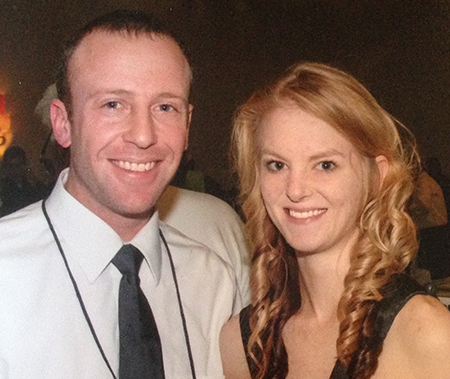|
When Courtney Beatty heard that the first day of the SnappGroup Masterminds meeting was going to be focused on behavioral science, she had her doubts. “I like facts and numbers, where 2+2 = 4 always,” she says. She felt like she would be outside of her comfort zone, but that only lasted a short time. In fact, she soon began to realize how much more efficiently the practice could run.

Dr. Perry and Courtney Beatty attended their first
Pearle Vision Summit in 2014.
Beatty has been working with Anthony Perry, OD, in one role or another since the end of 2009. When they first met, he was finishing optometry school and she was in finance and working as a technician at a LensCrafters. When Dr. Perry converted a corporate Pearle Vision location in Madison, Tennessee, to a lease in 2013, he asked Beatty to join him. Within a year, the practice saw a 25%-plus increase in revenue. In August 2016, Dr. Perry opened another Pearle location in Clarksville, Tennessee.
Both of them have been attending SnappGroup Masterminds sessions. “I’m learning a lot about how our profit and loss statements compare to other practices,” says Beatty. After an earlier Masterminds meeting, Dr. Perry and Beatty came up with a strategy for charging more for specialty contact lens fits. His colleagues helped him reset that specialty fits justified a higher charge—not necessarily because of the time they took but because of the expertise required. With a tiered contact lens fitting structure—and support to help staff explain it if asked—the practice gained thousands in additional revenue. That’s the kind of numbers-based decision-making that she’s comfortable with.
Personality color
So using The Color Code personality test to help her decipher her leadership style made Beatty a little uneasy. However, trainer Cathy Larsen was great, she says. “Doing the personality test made me reflect on my childhood. As part of a military family, I had to grow up quickly and be a kind of second mom,” she says. As she was going through those exercises, she began to see why some new employees say that she can be intimidating. “I have to have my day planned out. I want to be prepared, and I want to have a plan for things that can go wrong,” she says.
She realizes that to some people, that can seem inflexible and robotic. “As a ‘blue’ person, I recognize that my strength is that I can get things done. But I realize that people whose personalities are ‘yellow’ may need me to approach them differently,” she says.
The more she listened and began to think of her co-workers by their personality colors, the more she could see where their strengths were. For example, one co-worker is creative but takes critiques personally. “I couldn’t figure out how to provide constructive guidance without her feeling like I was criticizing her,” Beatty says.
Matching people and strengths
This session gave her an idea. When she came back to the office, Beatty asked this co-worker to start office-wide competitions and harness her positivity to create a better office environment. She ran with the idea and created a goal sheet with everyone’s name. There’s an opportunity to win individual prizes, and for bigger goals that require more teamwork, the whole team can be rewarded. “I can give her the positive feedback she wants because she’s doing a great job with this,” Beatty says.
Another co-worker has a peacemaker personality. “She’s great at organizing, so I’ve made her the project manager. She has created a process for contact lens and lab orders and reorders where there wasn’t one cohesive way before. The office is tidier, and everyone feels that it runs a little more smoothly,” Beatty says.
She says that now that she’s seen the successes, she is also more open to delegating. “It’s hard for me to delegate, but when we match a person with a task or project that fits their personality strengths, it’s great.”
|







